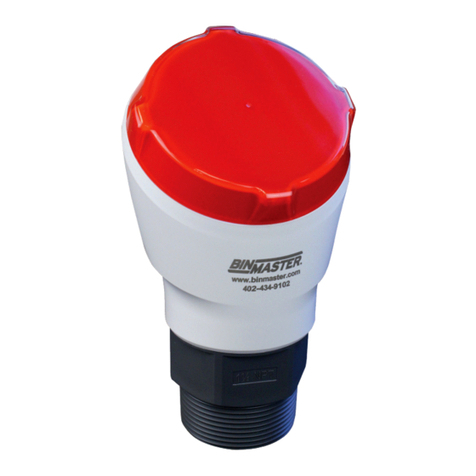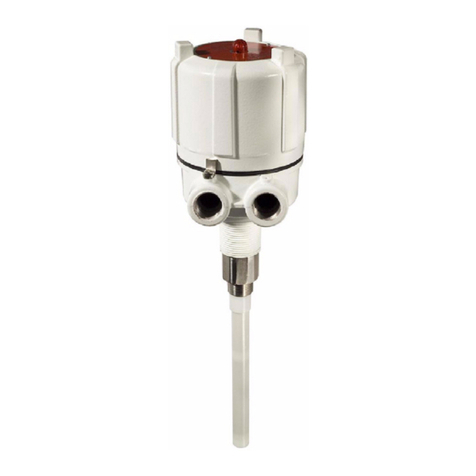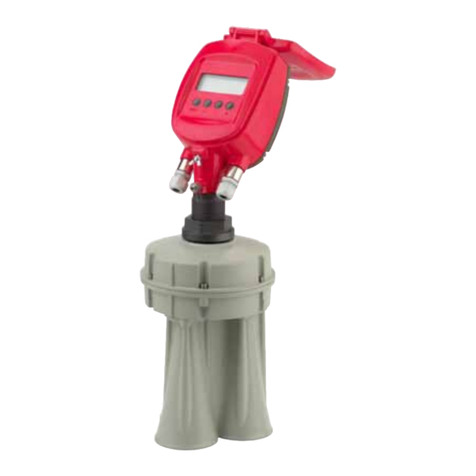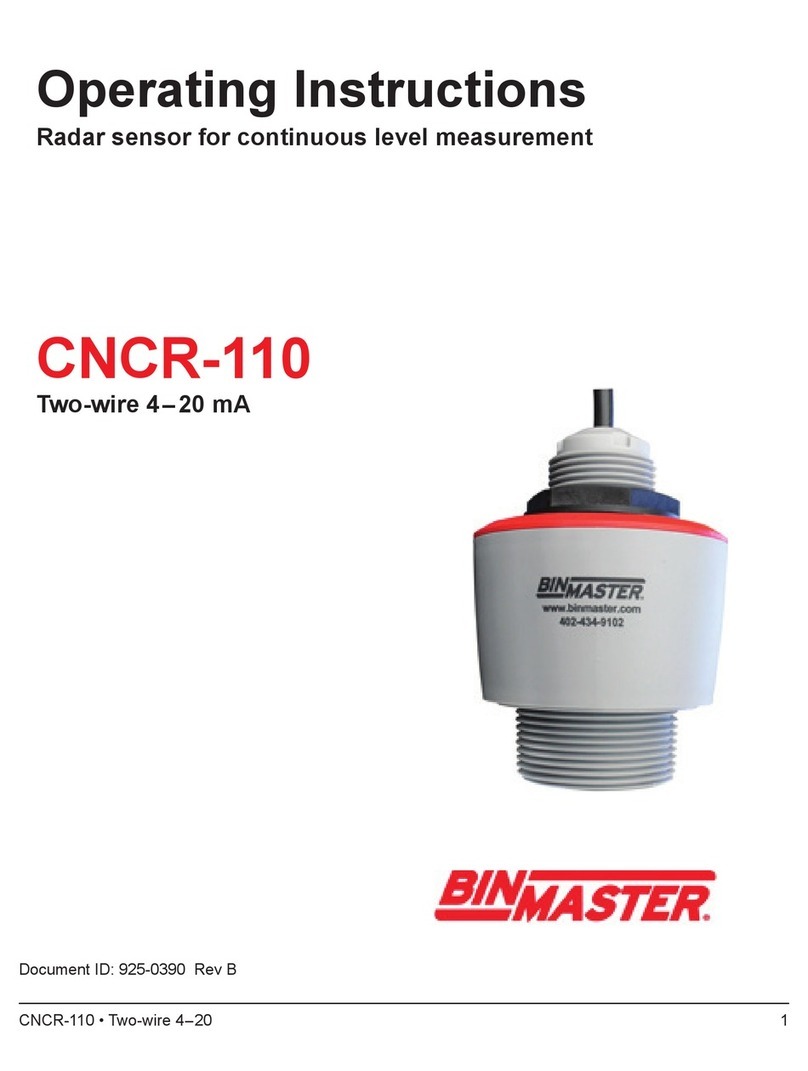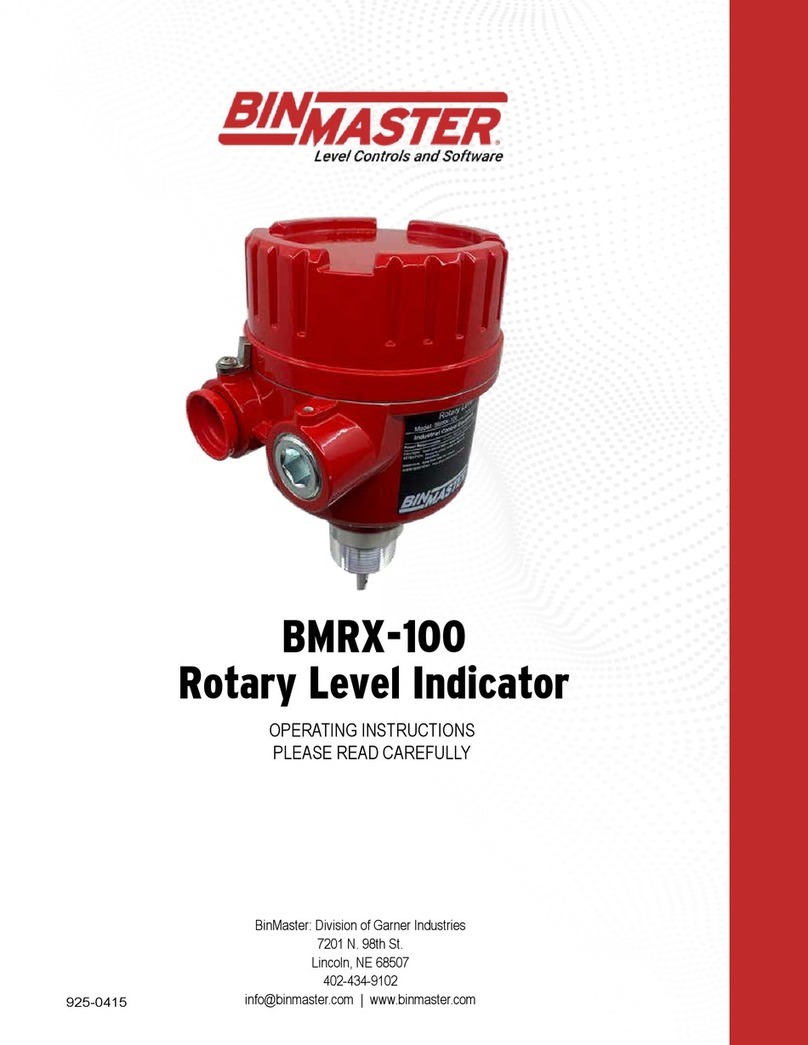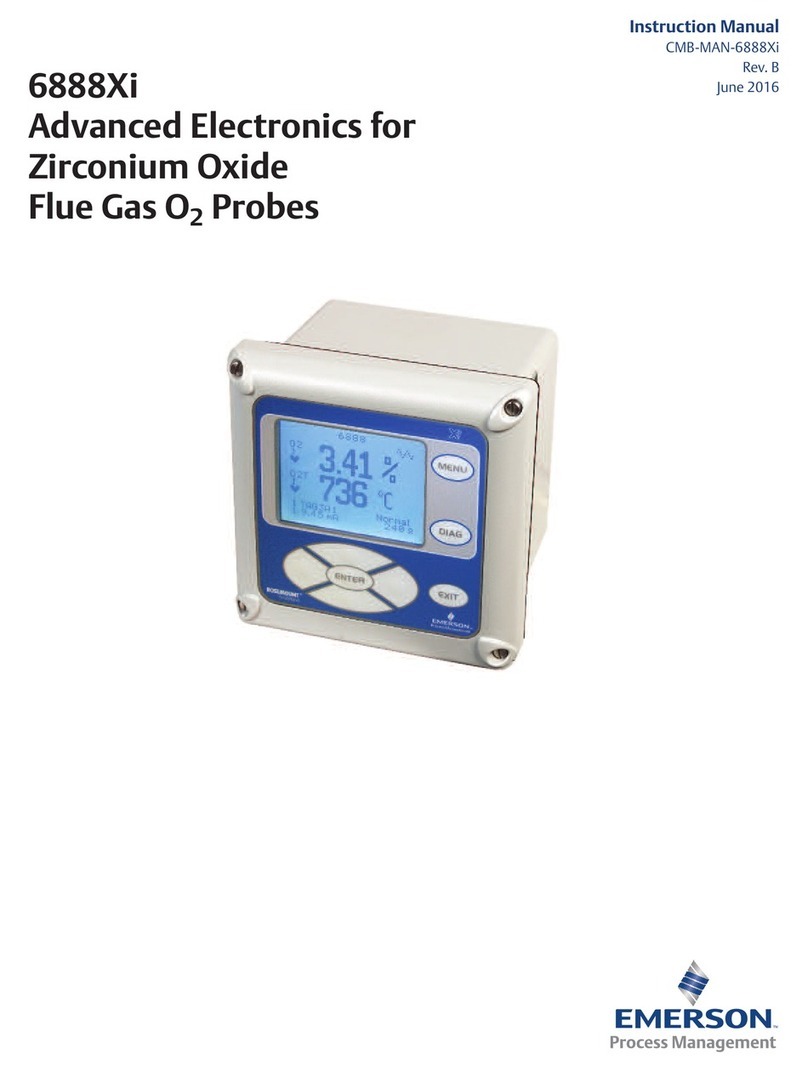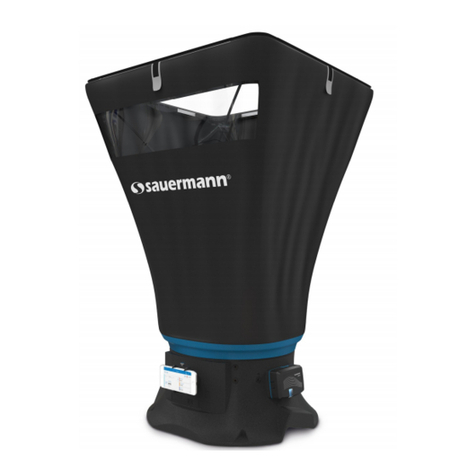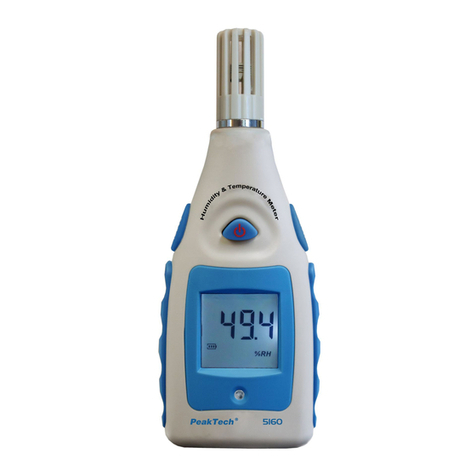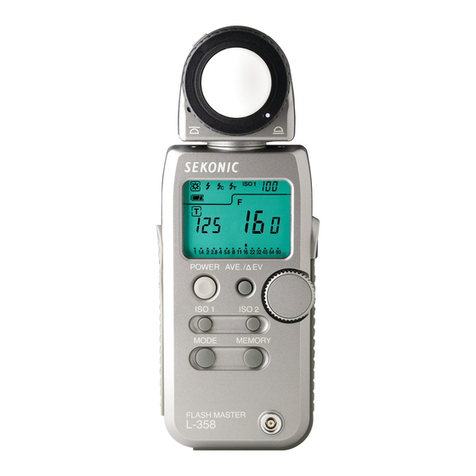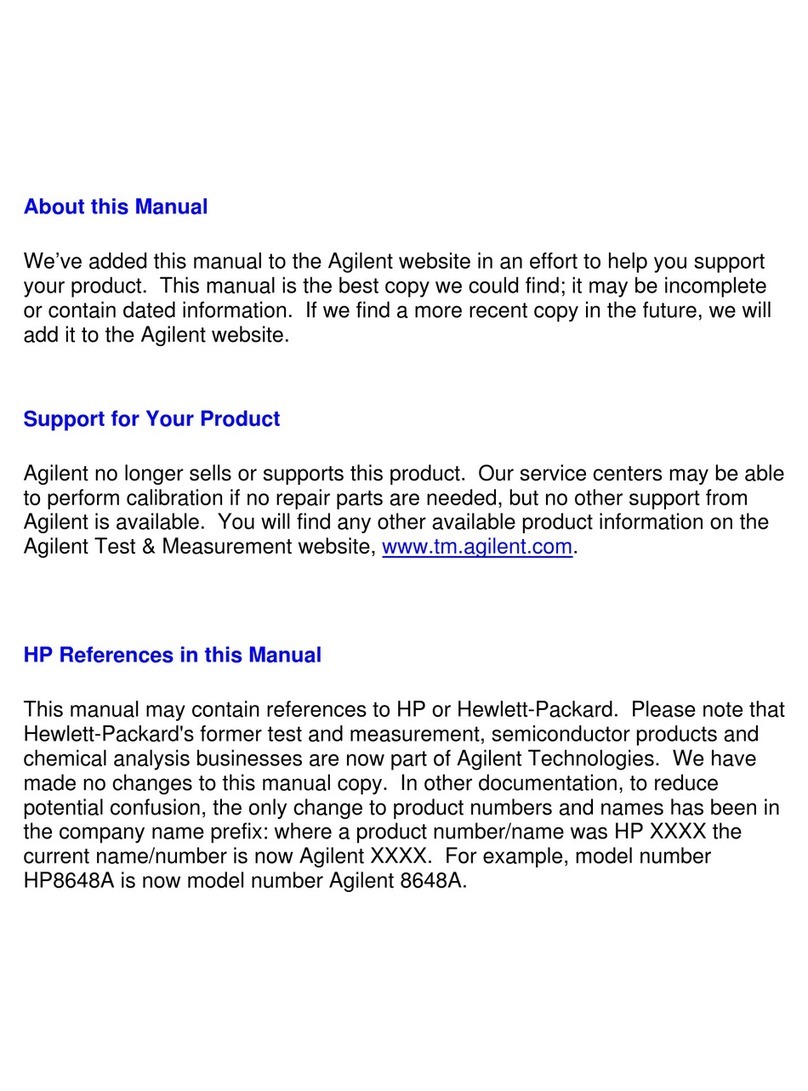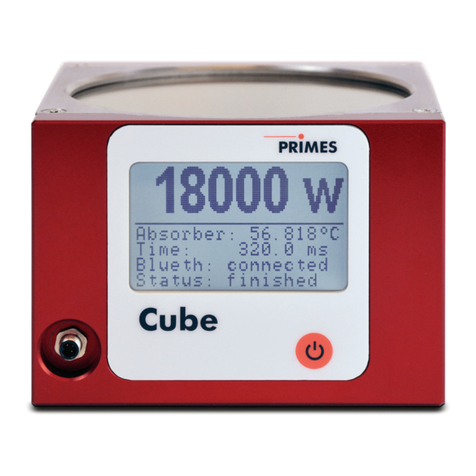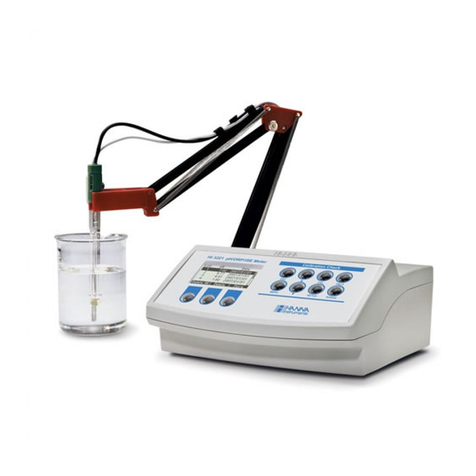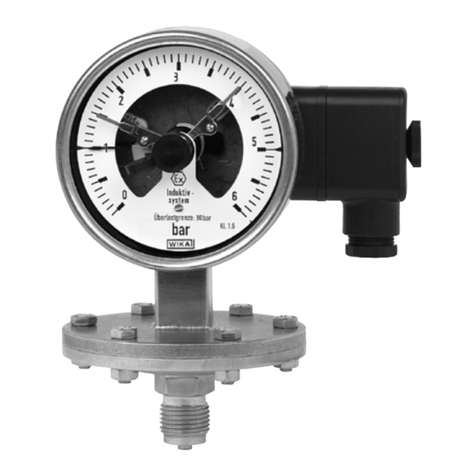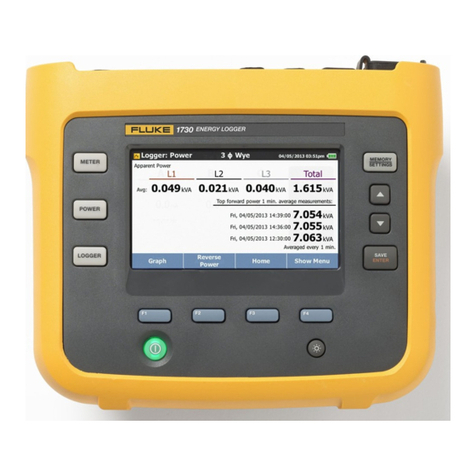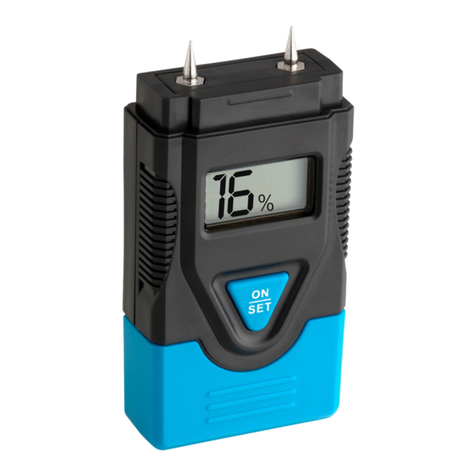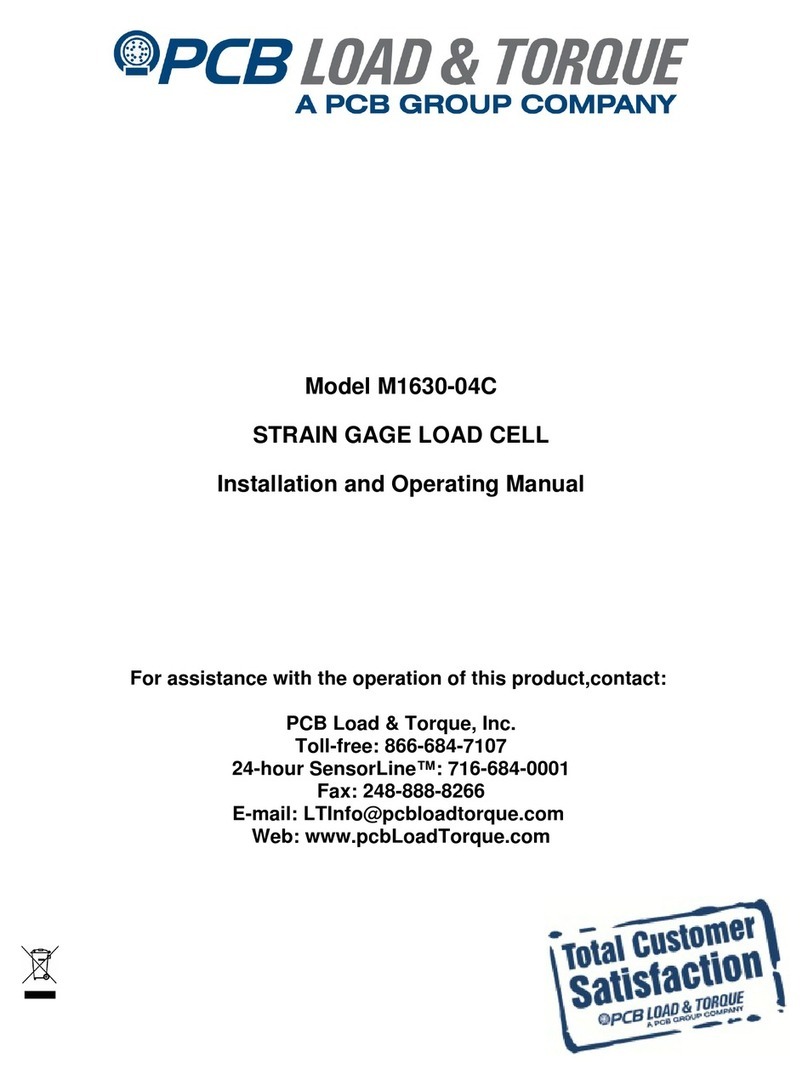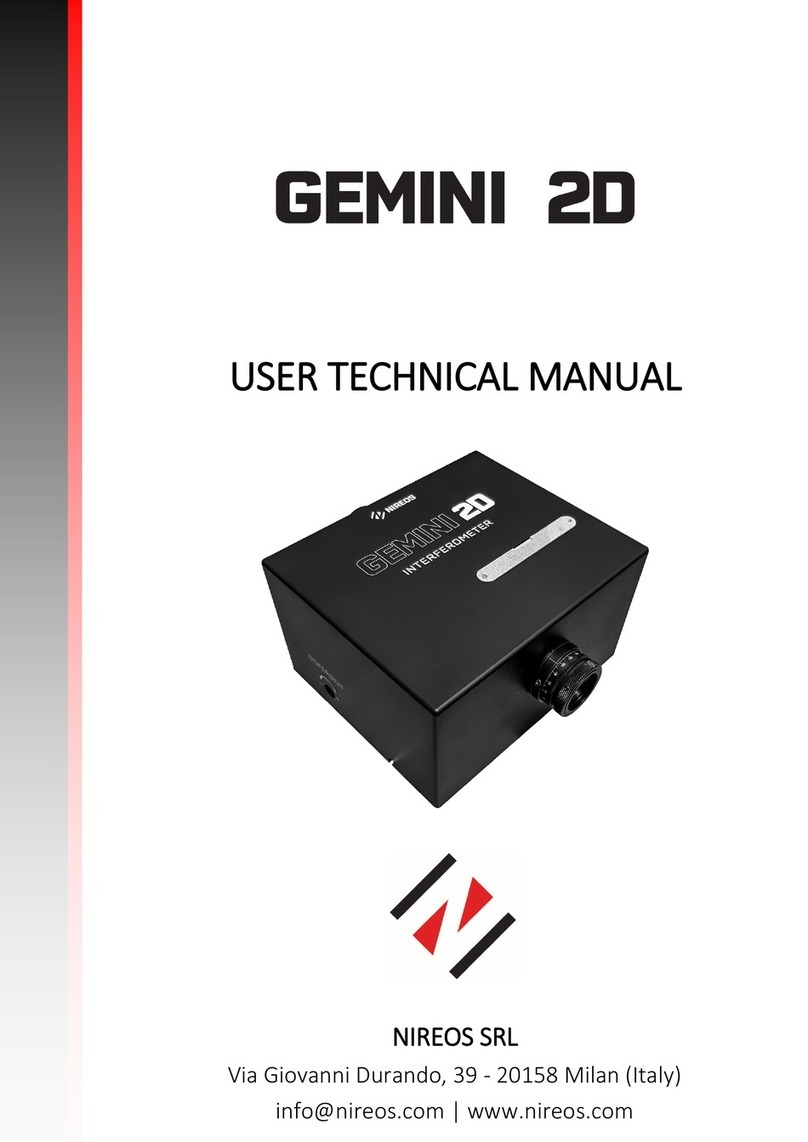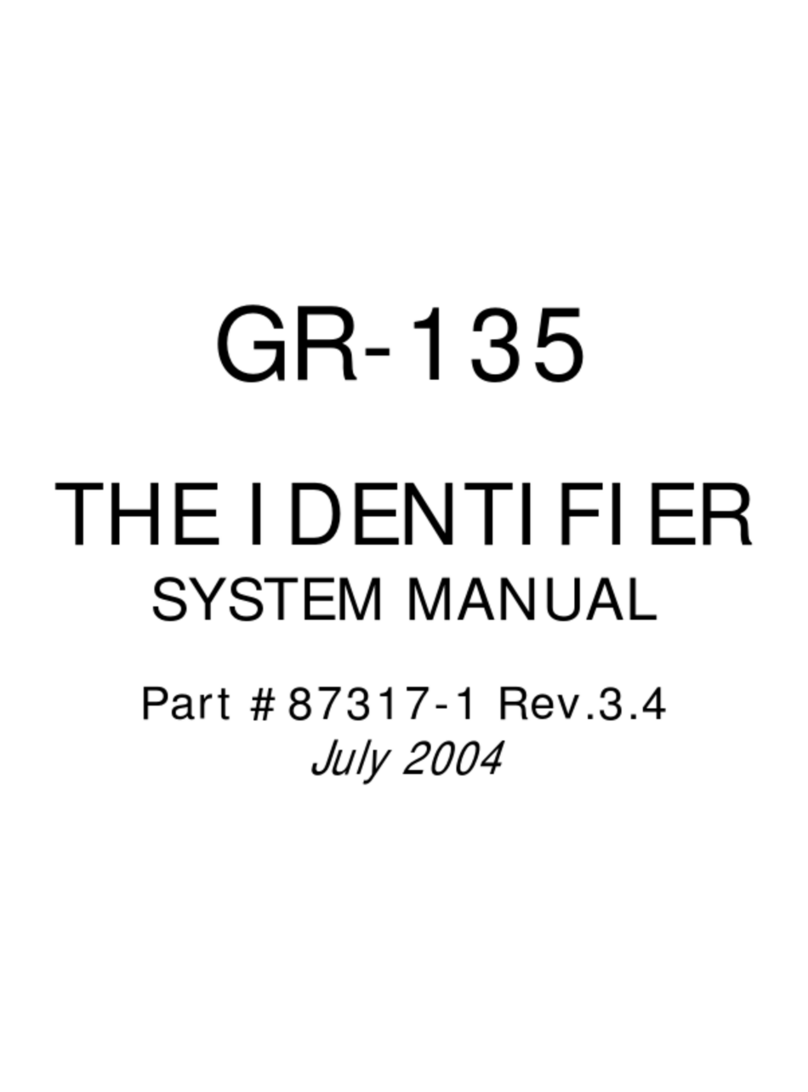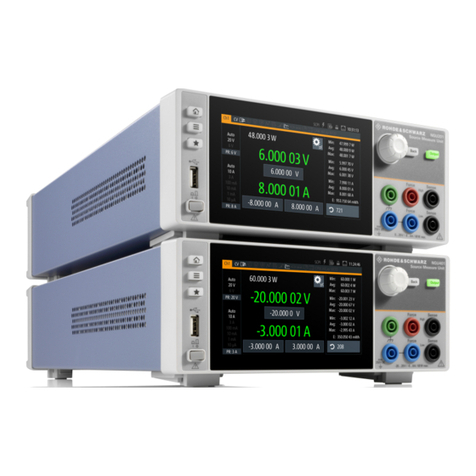Bin Master GWR-2000 User manual

GWR-2000 Four-wire 4-20 mA/HART
Operating Instructions
TDR sensor for continuous level measurement
of bulk solids
GWR-2000
Four-wire 4 - 20 mA/HART
Rod and cable probe
Document ID: 925-0335 Rev B

GWR-2000 Four-wire 4-20 mA/HART
925-0335 Rev B
2
Contents
Contents
1 About this document ................................................................................................. 4
1.1 Function............................................................................................................ 4
1.2 Target group ..................................................................................................... 4
1.3 Symbols used ................................................................................................... 4
2 For your safety ........................................................................................................... 5
2.1 Authorized personnel....................................................................................... 5
2.2 Appropriate use ................................................................................................ 5
2.3 Warning about incorrect use............................................................................. 5
2.4 General safety instructions ............................................................................... 5
2.5 CE conformity ................................................................................................... 6
2.6 NAMUR recommendations............................................................................... 6
2.7 Environmental instructions ............................................................................... 6
3 Product description ................................................................................................... 7
3.1 Conguration .................................................................................................... 7
3.2 Principle of operation........................................................................................ 8
3.3 Packaging, transport and storage..................................................................... 9
3.4 Accessories and replacement parts ................................................................. 9
4 Mounting ..................................................................................................................... 11
4.1 General instructions.......................................................................................... 11
4.2 Mounting instructions........................................................................................ 12
5 Connecting to power supply .................................................................................... 17
5.1 Preparing the connection.................................................................................. 17
5.2 Connection ....................................................................................................... 18
5.3 Wiring plan, double chamber housing .............................................................. 20
5.4 Supplementary electronics ............................................................................... 21
5.5 Switch-on phase ............................................................................................... 22
6 Set up the sensor with the display and adjustment module ................................. 23
6.1 Insert display and adjustment module .............................................................. 23
6.2 Adjustment system ........................................................................................... 24
6.3 Parameter adjustment - Quick setup ................................................................ 25
6.4 Parameter adjustment - Extended adjustment ................................................. 26
6.5 Saving the parameter adjustment data............................................................. 40
7 Setup with PACTware ................................................................................................ 42
7.1 Connect the PC ................................................................................................ 42

GWR-2000 Four-wire 4-20 mA/HART
925-0335 Rev B
Contents
3
7.2 Parameter adjustment ...................................................................................... 43
7.3 Set up with the quick setup............................................................................... 44
7.4 Saving the parameter adjustment data............................................................. 44
8 Set up with other systems ........................................................................................ 45
8.1 DD adjustment programs.................................................................................. 45
8.2 Field Communicator 375, 475 .......................................................................... 45
9 Diagnostics and servicing ........................................................................................ 46
9.1 Maintenance ..................................................................................................... 46
9.2 Diagnosis memory............................................................................................ 46
9.3 Status messages .............................................................................................. 47
9.4 Rectify faults ..................................................................................................... 51
9.5 Exchanging the electronics module.................................................................. 53
9.6 Exchange or shorten cable/rod......................................................................... 54
10 Removal ...................................................................................................................... 57
10.1 Removal steps................................................................................................. 57
10.2 Disposal............................................................................................................ 57
11 Supplement ................................................................................................................ 58
11.1 Technical data................................................................................................... 58
11.2 Dimensions....................................................................................................... 69
INDEX ...................................................................................................................................... 73
Safety instructions for Ex areas
Take note of the Ex specic safety instructions for Ex applications.
These instructions are attached as documents to each instrument
with Ex approval and are part of the operating instructions manual.

GWR-2000 Four-wire 4-20 mA/HART
925-0335 Rev B
1 About this document
4
1 About this document
1.1 Function
This operating instructions manual provides all the information you need for mounting, connec-
tion and setup as well as important instructions for maintenance and fault rectication. Please
read this information before putting the instrument into operation and keep this manual accessi-
ble in the immediate vicinity of the device.
1.2 Target group
This operating instructions manual is directed to trained specialist personnel. The contents of
this manual should be made available to these personnel and put into practice by them.
1.3 Symbols used
Information, tip, note
This symbol indicates helpful additional information.
Caution: If this warning is ignored, faults or malfunctions can result.
Warning: If this warning is ignored, injury to persons and/or serious damage to the in-
strument can result.
Danger: If this warning is ignored, serious injury to persons and/or destruction of the
instrument can result.
Ex applications
This symbol indicates special instructions for Ex applications.
List
The dot set in front indicates a list with no implied sequence.
Action
This arrow indicates a single action.
Sequence of actions
Numbers set in front indicate successive steps in a procedure.
Battery disposal
This symbol indicates special information about the disposal of batteries and accumula-
tors.
●
1

GWR-2000 Four-wire 4-20 mA/HART
925-0335 Rev B
2 For your safety
5
2 For your safety
2.1 Authorized personnel
All operations described in this operating instructions manual must be carried out only by trained
specialist personnel authorized by the plant operator.
During work on and with the device the required personal protective equipment must always be
worn.
2.2 Appropriate use
Operational reliability is ensured only if the instrument is properly used according to the speci-
cations in the operating instructions manual as well as possible supplementary instructions.
2.3 Warning about incorrect use
Inappropriate or incorrect use of the instrument can give rise to application-specic hazards,
e.g. vessel overll or damage to system components through incorrect mounting or adjustment.
Also the protective characteristics of the instrument can be inuenced.
2.4 General safety instructions
This is a state-of-the-art instrument complying with all prevailing regulations and guidelines. The
instrument must only be operated in a technically awless and reliable condition. The operator is
responsible for the trouble-free operation of the instrument.
During the entire duration of use, the user is obliged to determine the compliance of the nec-
essary occupational safety measures with the current valid rules and regulations and also take
note of new regulations.
The safety instructions in this operating instructions manual, the national installation standards
as well as the valid safety regulations and accident prevention rules must be observed by the
user.
For safety and warranty reasons, any invasive work on the device beyond that described in the
operating instructions manual may be carried out only by personnel authorised by the manufac-
turer. Arbitrary conversions or modications are explicitly forbidden.
The safety approval markings and safety tips on the device must also be observed.
Depending on the instrument version, the emitting frequencies are in the C, K or W band range.
The low emitting frequencies are far below the internationally approved limit values. When used
correctly, the device poses no danger to health.

GWR-2000 Four-wire 4-20 mA/HART
925-0335 Rev B
2 For your safety
6
2.5 CE conformity
The device fulls the legal requirements of the applicable EC guidelines. By axing the CE
marking, we conrm successful testing of the product.
Electromagnetic compatibility
Instruments in four-wire or Ex-d-ia version are designed for use in an industrial environment.
Nevertheless, electromagnetic interference from electrical conductors and radiated emissions
must be taken into account, as is usual with class A instruments according to EN 61326-1. If the
instrument is used in a dierent environment, the electromagnetic compatibility to other instru-
ments must be ensured by suitable measures.
2.6 NAMUR recommendations
NAMUR is the automation technology user association in the process industry in Germany. The
published NAMUR recommendations are accepted as the standard in eld instrumentation.
The device fulls the requirements of the following NAMUR recommendations:
●NE 21 – Electromagnetic compatibility of equipment
●NE 43 – Signal level for malfunction information from measuring transducers
●NE 53 – Compatibility of eld devices and display/adjustment components
●NE 107 – Self-monitoring and diagnosis of eld devices
For further information see www.namur.de.
2.7 Environmental instructions
Protection of the environment is one of our most important duties. That is why we have intro-
duced an environment management system with the goal of continuously improving company
environmental protection. The environment management system is certied according to DIN
EN ISO 14001.
Please help us full this obligation by observing the environmental instructions in this manual:
●Chapter "Packaging, transport and storage"
●Chapter "Disposal"

GWR-2000 Four-wire 4-20 mA/HART
925-0335 Rev B
3 Production description
7
3 Product description
3.1 Conguration
The type label contains the most important data for identication and use of the instrument:
Fig. 1: Layout of the type label
1 Instrument type
2 Product code
3 Approvals
4 Voltage supply and signal output, electronics
5 Protection rating
6 Measuring range
7 Process and ambient temperature, process pressure
8 Material, wetted parts
9 Hardware and software version
10 Order number
11 Serial number of the instrument
12 Data matrix code for smartphone app
13 Symbol of the device protection class
14 ID numbers, instrument documentation
15 Reminder to observe the instrument documentation
The type label contains the serial number of the instrument. With it you can nd the following
instrument data on our homepage:
●Product code (HTML)
●Delivery date (HTML)
●Order-specic instrument features (HTML)
●Operating instructions and quick setup guide at the time of shipment (PDF)
●Order-specic sensor data for an electronics exchange (XML)

GWR-2000 Four-wire 4-20 mA/HART
925-0335 Rev B
3 Production description
8
This operating instructions manual applies to the following instrument versions:
●Hardware version from 1.0.0
●Software version from 1.2.0
●Only for instrument versions without SIL qualication
The instrument and the electronics version can be determined via the product code on the type
label as well as on the electronics.
●Standard electronics with operating voltage 90 … 253 V AC; 50/60 Hz: Typ FX80B.-
●Standard electronics with supply voltage 9.6 … 48 V DC; 20 … 42 V AC: Type FX80I.-
The scope of delivery encompasses:
●Sensor
●Documentation
- Quick setup guide
- Test certicate measuring accuracy (optional)
- Supplementary instructions "GSM/GPRS radio module" (optional)
- Supplementary instructions manual "Heating for display and adjustment module" (op-
tional)
- Supplementary instructions manual "Plug connector for continuously measuring sensors"
(optional)
- Ex-specic "Safety instructions" (with Ex versions)
- If necessary, further certicates
Information:
In this operating instructions manual, the optional instrument features are described. The re-
spective scope of delivery results from the order specication.
3.2 Principle of operation
The GWR-2000 is a level sensor with cable or rod probe for continuous level measurement,
suitable for applications in bulk solids.
High frequency microwave pulses are guided along a steel cable or a rod. Upon reaching the
product surface, the microwave pulses are reected. The running time is evaluated by the in-
strument and outputted as level.
Probe end tracking
To increase sensitivity, the probe is equipped with probe end tracking. In bulk solids with a low
dielectric constant, this function is very helpful. This is the case, for example, in plastic granules,
packing chips or in vessels with uidized products.
Between a dielectric constant of 1.5 and 3, the function switches on, if required. As soon as the
level echo can no longer be detected, probe end tracking is automatically activated. The mea-
surement is continued with the last calculated dielectric constant.
The accuracy thus depends on the stability of the dielectric constant.

GWR-2000 Four-wire 4-20 mA/HART
925-0335 Rev B
3 Production description
9
If you measure a medium with a dielectric constant below 1.5, probe end tracking is always
active. In this case, you have to enter the dielectric constant of the bulk solid. A stable dielectric
constant is very important here.
3.3 Packaging, transport and storage
Your instrument was protected by packaging during transport. Its capacity to handle normal
loads during transport is assured by a test based on ISO 4180.
The packaging of standard instruments consists of environment friendly, recyclable cardboard.
For special versions, PE foam or PE foil is also used. Dispose of the packaging material via
specialised recycling companies.
Transport must be carried out in due consideration of the notes on the transport packaging. Non-
observance of these instructions can cause damage to the device.
The delivery must be checked for completeness and possible transit damage immediately at re-
ceipt. Ascertained transit damage or concealed defects must be appropriately dealt with.
Up to the time of installation, the packages must be left closed and stored according to the ori-
entation and storage markings on the outside.
Unless otherwise indicated, the packages must be stored only under the following conditions:
●Not in the open
●Dry and dust free
●Not exposed to corrosive media
●Protected against solar radiation
●Avoiding mechanical shock and vibration
●Storage and transport temperature see chapter “Supplement - Technical data - Ambient con-
ditions”
●Relative humidity 20 … 85 %
3.4 Accessories and replacement parts
The display and adjustment module BinDisc is used for measured value indication, adjustment
and diagnosis. It can be inserted into the sensor and removed at any time.
You can nd further information in the operating instructions “Display and adjustment module”.
The protective cover protects the sensor housing against soiling and intense heat from solar
radiation.
Screwed anges are available in dierent versions according to the following standards: DIN
2501, EN 1092-1, BS 10, ASME B 16.5, JIS B 2210-1984, GOST 12821-80.
The display and adjustment module can be optionally replaced by a display and adjustment
module with heating function.
You can use this display and adjustment module in an ambient temperature range of -40…+70
°C.

GWR-2000 Four-wire 4-20 mA/HART
925-0335 Rev B
3 Production description
10
You can nd further information in the operating instructions "Display and adjustment module
with heating".
If the standard sensor housing is too big or in case of strong vibrations, an external housing can
be used.
Then the sensor housing is made of stainless steel. The electronics is located in the external
housing which can be mounted in a distance of up to 10 m (147 ft) to the sensor by using a con-
nection cable.
You can nd additional information in the operating instructions manual "External housing".
If you are using an instrument with rod version, you can extend the rod probe individually with
curved segments and rod and cable extensions of dierent lengths.
All extensions used must not exceed a total length of 6 m (19.7 ft).
The extensions are available in the following lengths:
Rod: ø 16 mm (0.63 in)
●Basic segments: 20 … 5900 mm (0.79 … 232 in)
●Rod/cable segments: 20 … 5900 mm (0.79 … 232 in)
●Curved segments: 100 x 100 mm (3.94 … 3.94 in)
You can nd further information in the operating instructions manual "Rod and cable compo-
nents".
If you mount the GWR-2000 in a bypass tube or standpipe, you have to avoid contact to the by-
pass tube by using a spacer at the probe end.
You can nd additional information in the operating instructions manual "Centering".

GWR-2000 Four-wire 4-20 mA/HART
925-0335 Rev B
4 Mounting
11
4 Mounting
4.1 General instructions
On instruments with threaded process tting, the hexagon must be tightened with a suitable
wrench. For the proper wrench size see chapter "Dimensions".
Warning:
The housing must not be used to screw the instrument in! Applying tightening force can damage
internal parts of the housing.
Protect your instrument against moisture ingress through the following measures:
●Use the recommended cable (see chapter “Connecting to power supply”)
●Tighten the cable gland
●When mounting horizontally, turn the housing so that the cable gland points downward
●Loop the connection cable downward in front of the cable gland
This applies mainly to outdoor installations, in areas where humidity is expected (e.g. through
cleaning processes) and on cooled or heated vessels.
Metric threads
In the case of instrument housings with metric thread, the cable glands are screwed in at the
factory. They are sealed with plastic plugs as transport protection.
You have to remove these plugs before electrical connection.
NPT thread
In the case of instrument housings with self-sealing NPT threads, it is not possible to have the
cable entries screwed in at the factory. The free openings for the cable glands are therefore
covered with red dust protection caps as transport protection. The dust protection caps do not
provide sucient protection against moisture.
Prior to setup you have to replace these protective caps with approved cable glands or close the
openings with suitable blind plugs.
The mounting position and orientation of the sensor must take into account the limitations in
chapter “For your safety”, “Radio approval for USA” “Radio approval for Canada” of this operat-
ing instructions.
Make sure that all parts of the instrument exposed to the process are suitable for the existing
process conditions.
These are mainly:
●Active measuring component
●Process tting
●Process seal
Process conditions are particularly:
●Process pressure
●Process temperature
●Chemical properties of the medium
●Abrasion and mechanical inuences

GWR-2000 Four-wire 4-20 mA/HART
925-0335 Rev B
4 Mounting
12
You can nd detailed information on the process conditions in chapter "Technical data" as well
as on the type label.
4.2 Mounting instructions
Mount the GWR-2000 in such a way that the distance to vessel installations or to the vessel wall
is at least 300 mm (12 in). In non-metallic vessels, the distance to the vessel wall should be at
least 500 mm (19.7 in).
During operation, the probe must not touch any installations or the vessel wall. If necessary, fas-
ten the probe end.
In vessels with conical bottom it can be advantageous to mount the sensor in the center of the
vessel, as measurement is then possible nearly down to the lowest point of the bottom. Keep in
mind that measurement all the way down to the tip of the probe may not be possible. The exact
value of the min. distance (lower dead band) is stated in chapter "Technical data".
Fig. 2: Vessel with conical bottom
Plastic vessel/Glass vessel
The guided microwave principle requires a metallic surface on the process tting. Therefore, in
plastic vessels, etc., use an instrument version with ange (from DN 50) or place a metal sheet
(ø > 200 mm/8 in) beneath the process tting when screwing it in.
Make sure that the plate has direct contact with the process tting.
When installing the probes without metal vessel wall, e.g. in plastic vessels, the measured value
can be inuenced by strong electromagnetic elds (emitted interference according to EN 61326:
class A).
Use a probe in coax version for applications in liquids.

GWR-2000 Four-wire 4-20 mA/HART
925-0335 Rev B
4 Mounting
13
Fig. 3: Installation in non-metallic vessel
1 Flange
2 Metal sheet
Concrete vessel
When installed in thick concrete ceilings, GWR-2000 should be mounted front ush to the lower
edge. In concrete silos, the distance to the wall should be at least 500 mm (20 in).
Fig. 4: Installation in concrete silo
If possible, avoid sockets. Mount the sensor ush with the vessel top. If this is not possible, use
short sockets with small diameter.

GWR-2000 Four-wire 4-20 mA/HART
925-0335 Rev B
4 Mounting
14
Higher sockets or sockets with a bigger diameter can generally be used. They can, however, in-
crease the upper blocking distance (dead band). Check if this is relevant for your measurement.
In such cases, always carry out a false signal suppression after installation. You can nd further
information under "Setup procedure".
Fig. 5: Mounting socket
When welding the socket, make sure that the socket is ush with the vessel top.
Fig. 6: Socket must be installed ush
1 Unfavourable installation
2 Socket ush - optimum installation
Before beginning the welding work, remove the electronics module from the sensor. By doing
this, you avoid damage to the electronics through inductive coupling.
Do not mount the instruments in or above the lling stream. Make sure that you detect the prod-
uct surface, not the inowing product.

GWR-2000 Four-wire 4-20 mA/HART
925-0335 Rev B
4 Mounting
15
Fig. 7: Mounting of the sensor with inowing medium
The reference plane for the measuring range of the sensors is the sealing surface of the thread
or ange.
Keep in mind that a min. distance must be maintained below the reference plane and possibly
also at the end of the probe - measurement in these areas is not possible (dead band). The
length of the cable can be used all the way to the end only when measuring conductive prod-
ucts. These blocking distances for dierent mediums are listed in chapter "Technical data". Keep
in mind for the adjustment that the default setting for the measuring range refers to water.
The process tting must be sealed if there is gauge or low pressure in the vessel. Before use,
check if the seal material is resistant against the measured product and the process tempera-
ture.
The max. permissible pressure is specied in chapter "Technical data" or on the type label of the
sensor.
If there is a risk of the cable probe touching the vessel wall during operation due to product
movements or agitators, etc., the measuring probe should be securely xed.
In the gravity weight there is an internal thread (M12), e.g. for an eyebolt (optional) - (article no.
2.27423).
Make sure that the probe cable is not completely taut. Avoid tensile loads on the cable.
Avoid undened vessel connections, i.e. the connection must be either grounded reliably or iso-
lated reliably. Any undened change of this condition can lead to measurement errors.
If there is a danger of the rod probe touching the vessel wall, then the probe must be fastened
at the bottom end.
Keep in mind that below the fastening, a measurement is not possible.

GWR-2000 Four-wire 4-20 mA/HART
925-0335 Rev B
4 Mounting
16
Fig. 8: Fasten the probe
1 Measuring probe
2 Retaining sleeve
In case of dicult installation conditions in liquid applications, the probe can be also mounted
laterally. For this purpose, adapt the rod with rod extensions or bow-shaped segments.
To compensate for the resulting changes in signal runtime, let the instrument determine the
probe length automatically.
The determined probe length can deviate from the actual probe length when using curved or
angled segments.
If internal installations such as struts, ladders, etc. are present on the vessel wall, the measuring
probe should be mounted at least 300 mm (11.81 in) away from the vessel wall.
You can nd further information in the supplementary instructions of the rod extension.
In case of dicult installation conditions, for example in a socket, the probe can be suitably
adapted with a rod extension.
To compensate for the resulting changes in signal runtime, let the instrument determine the
probe length automatically.
You can nd further information in the supplementary instructions of the rod and cable compo-
nents.

GWR-2000 Four-wire 4-20 mA/HART
925-0335 Rev B
5 Connecting to power supply
17
5 Connecting to power supply
5.1 Preparing the connection
Always keep in mind the following safety instructions:
Warning:
Connect only in the complete absence of line voltage.
●The electrical connection must only be carried out by trained personnel authorized by the
plant operator.
●If overvoltage surges are expected, overvoltage arresters should be installed.
Note:
Install a separating facility for the instrument which is easy to access. The separating facility
must be marked for the instrument (IEC/EN 61010).
Voltage supply via mains voltage
In this case, the instrument is designed in protection class I. To maintain this protection class, it
is absolutely necessary that the ground conductor be connected to the internal ground terminal.
Take note of the national installation regulations.
Supply voltage and current signal are carried on separate connection cables if reliable separa-
tion is required. The supply voltage range can dier depending on the instrument version.
The data for power supply are specied in chapter "Technical data".
Voltage supple via low voltage
In this case, the instrument is designed in protection class II. Generally connect the instrument
to vessel ground (potential equalization) or with plastic vessels to the next ground potential. For
this purpose, a ground terminal is located laterally on the instrument housing.
Connection Cable
An approved, three-wire installation cable with PE conductor is required for voltage supply with
mains voltage.
The 4 … 20 mA current output is connected with standard two-wire cable without screen. If
electromagnetic interference is expected which is above the test values of EN 61326-1 for in-
dustrial areas, screened cable should be used.
For instruments with housing and cable gland, use cable with round cross-section. To ensure
the seal eect of the cable gland (IP protec- tion rating), you have to check for which cable outer
diameter the cable gland is suitable.
Use a cable gland tting the cable diameter.
Metric threads
In the case of instrument housings with metric thread, the cable glands are screwed in at the
factory. They are sealed with plastic plugs as transport protection.
You have to remove these plugs before electrical connection.

GWR-2000 Four-wire 4-20 mA/HART
925-0335 Rev B
5 Connecting to power supply
18
NPT thread
In the case of instrument housings with self-sealing NPT threads, it is not possible to have the
cable entries screwed in at the factory. The free openings for the cable glands are therefore cov-
ered with red dust protection caps as transport protection.
Prior to setup you have to replace these protective caps with approved cable glands or close the
openings with suitable blind plugs.
With plastic housing, the NPT cable gland or the Conduit steel tube must be screwed without
grease into the threaded insert.
Max. torque for all housings, see chapter "Technical data".
If screened cable is required, we recommend connecting the cable screen on both ends to
ground potential. In the sensor, the screen should be connected directly to the internal ground
terminal. The ground terminal on the outside of the housing must be connected to the ground
potential (with low impedance).
In Ex systems, the grounding is carried out according to the installation regulations.
In electroplating and CCP systems (cathodic corrosion protection) it must be taken into account
that signicant potential dierences exist. This can lead to unacceptably high currents in the ca-
ble screen if it is grounded at both ends.
Information:
The metallic parts of the instrument (process tting, sensor, concentric tube, etc.) are connected
with the internal and external ground terminal on the housing. This connection exists either
directly via the conductive metallic parts or, in case of instruments with external electronics, via
the screen of the special connection cable.
You can nd specications on the potential connections inside the instrument in chapter "Techni-
cal data".
5.2 Connection
The voltage supply and signal output are connected via the spring loaded terminals in the hous-
ing.
Connection to the display and adjustment module or to the interface adapter is carried out via
contact pins in the housing.
Information:
The terminal block is pluggable and can be removed from the electronics. To do this, lift the
terminal block with a small screwdriver and pull it out. When reinserting the terminal block, you
should hear it snap in.
Proceed as follows:
1. Unscrew the housing lid
2. If a display and adjustment module is installed, remove it by turning it slightly to the left.
3. Loosen compression nut of the cable gland and remove blind plug
4. Remove approx. 10 cm (4 in) of the cable mantle (signal output), strip approx. 1 cm (0.4 in)
insulation from the ends of the individual wires

GWR-2000 Four-wire 4-20 mA/HART
925-0335 Rev B
5 Connecting to power supply
19
Fig. 9: Connection steps 6 and 7
6. Insert the wire ends into the terminals according to the wiring plan
Information:
Solid cores as well as exible cores with wire end sleeves are inserted directly into the terminal
openings. In case of exible cores without end sleeves, press the terminal from above with a
small screwdriver, the terminal opening is then free. When the screwdriver is released, the ter-
minal closes again.
7. Check the hold of the wires in the terminals by lightly pulling on them
8. Connect the screen to the internal ground terminal, connect the outer ground terminal to po-
tential equalisation in case of power supply via low voltage
9. Connect the lead cable for power supply in the same way according to the wiring plan, in ad-
dition connect the ground conductor to the inner ground terminal when powered with mains
voltage.
10. Tighten the compression nut of the cable glands. The seal ring must completely encircle the
cables
11. Screw the housing lid back on
The electrical connection is nished.
Information:
The terminal blocks are pluggable and can be removed from the housing insert. To do this, lift
the terminal block with a small screwdriv- er and pull it out. When inserting the terminal block
again, you should hear it snap in.
5. Insert the cable into the sensor through the cable entry

GWR-2000 Four-wire 4-20 mA/HART
925-0335 Rev B
5 Connecting to power supply
20
5.3 Wiring plan, double chamber housing
The following illustrations apply to the non-Ex as well as to the Ex-d-ia version.
Fig. 10: Electronics compartment, double chamber housing
1 Internal connection to the terminal compartment
2 For display and adjustment module or interface adapter
Information:
The connection of an external display and adjustment unit is not possible with the Ex-d-ia ver-
sion.
Fig. 11: Connection compartment with double chamber housing with mains voltage
Terminal Function Polarity
1 Voltage supply +/L
2 Voltage supply -/N
4 ... 20 mA output (active) +
6 4 ... 20 mA output (passive) +
7 Mass - output -
8 Function ground when installing ac-
cording to CSA (Canadian Standards
Association)
Other manuals for GWR-2000
2
Table of contents
Other Bin Master Measuring Instrument manuals
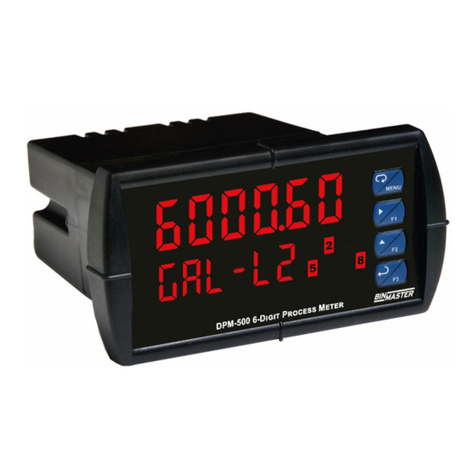
Bin Master
Bin Master DPM-500 User manual
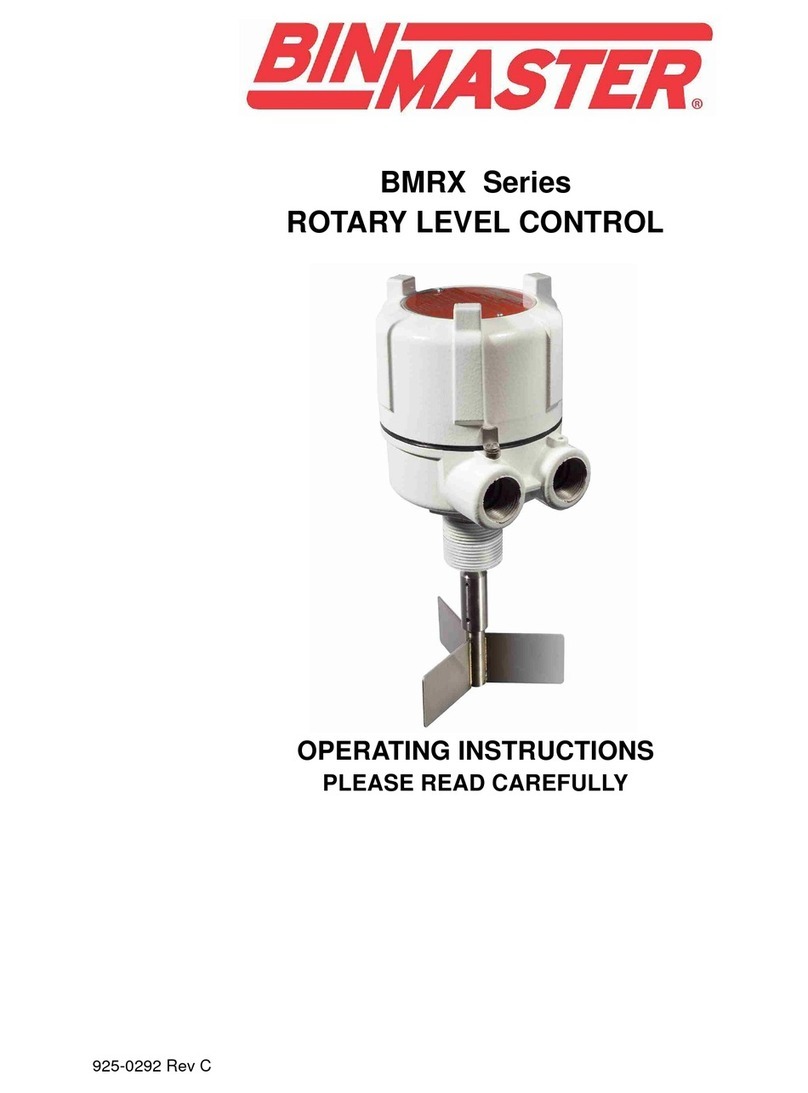
Bin Master
Bin Master BMRX Series User manual
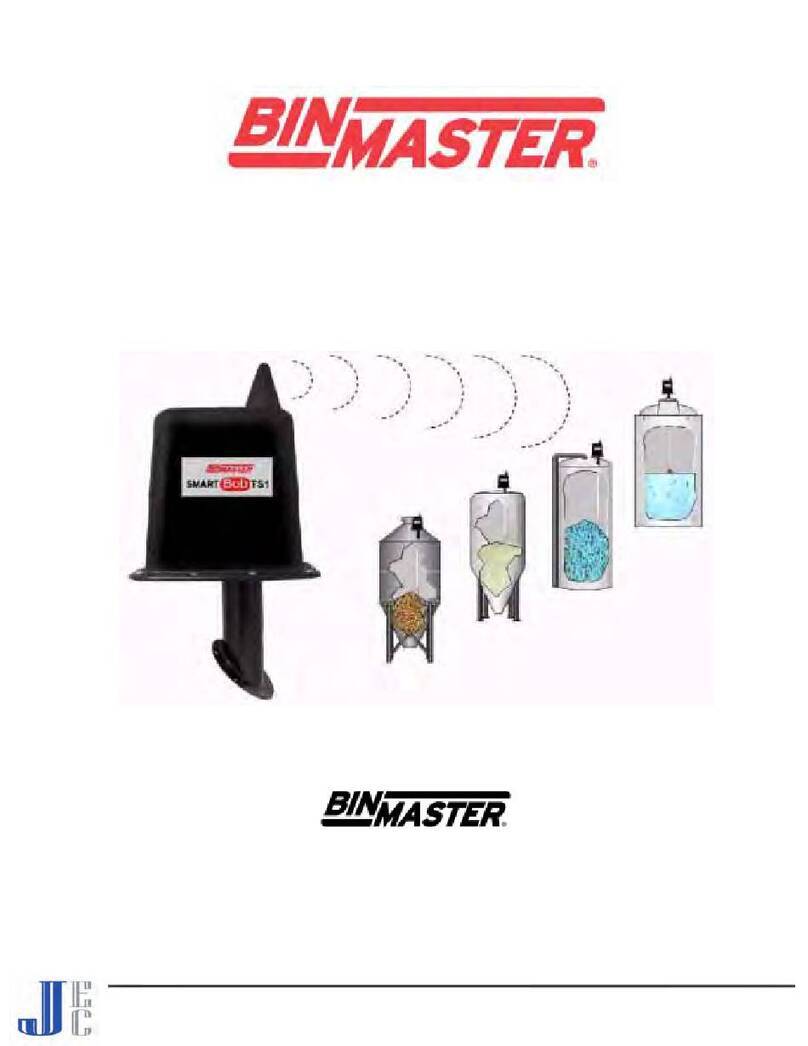
Bin Master
Bin Master SMARTBOB TS1 User manual

Bin Master
Bin Master DPM-400 User manual
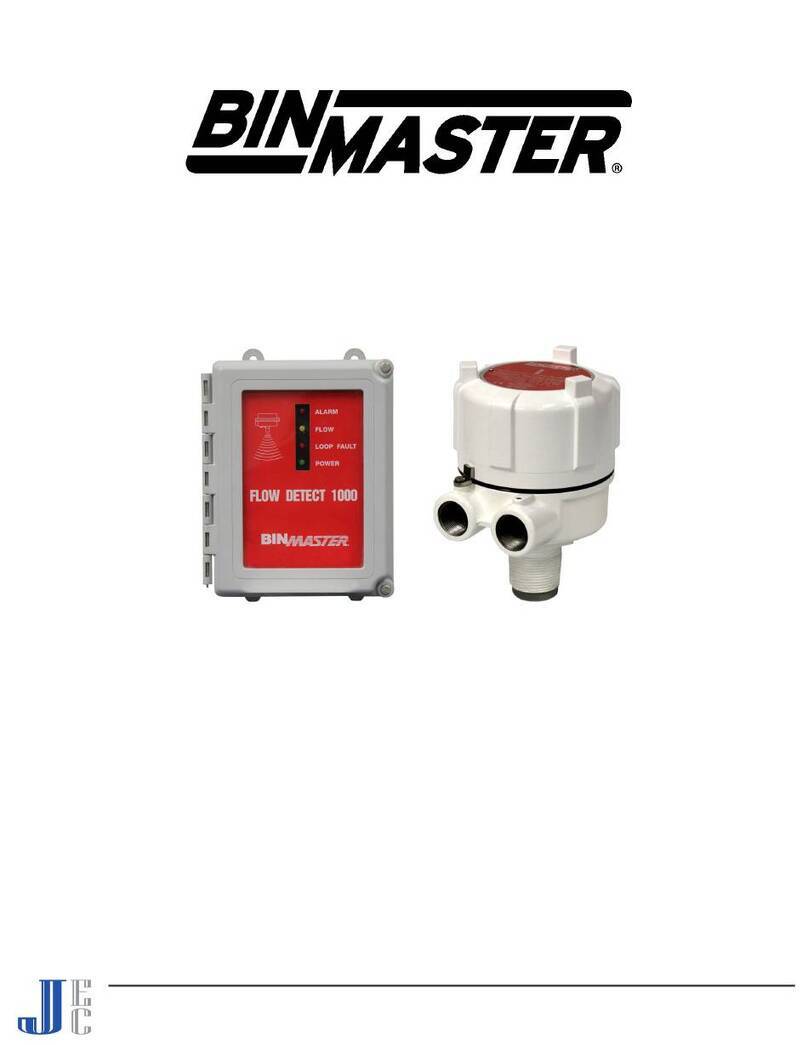
Bin Master
Bin Master 1000 User manual
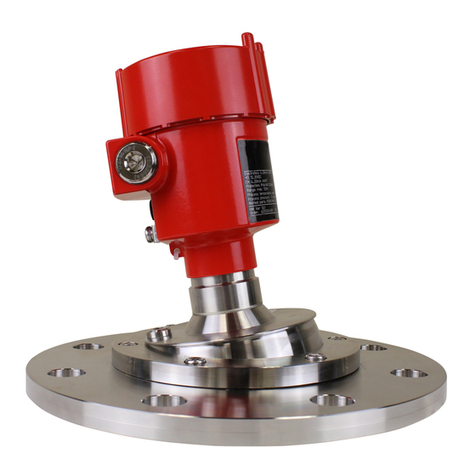
Bin Master
Bin Master NCR-80 User manual
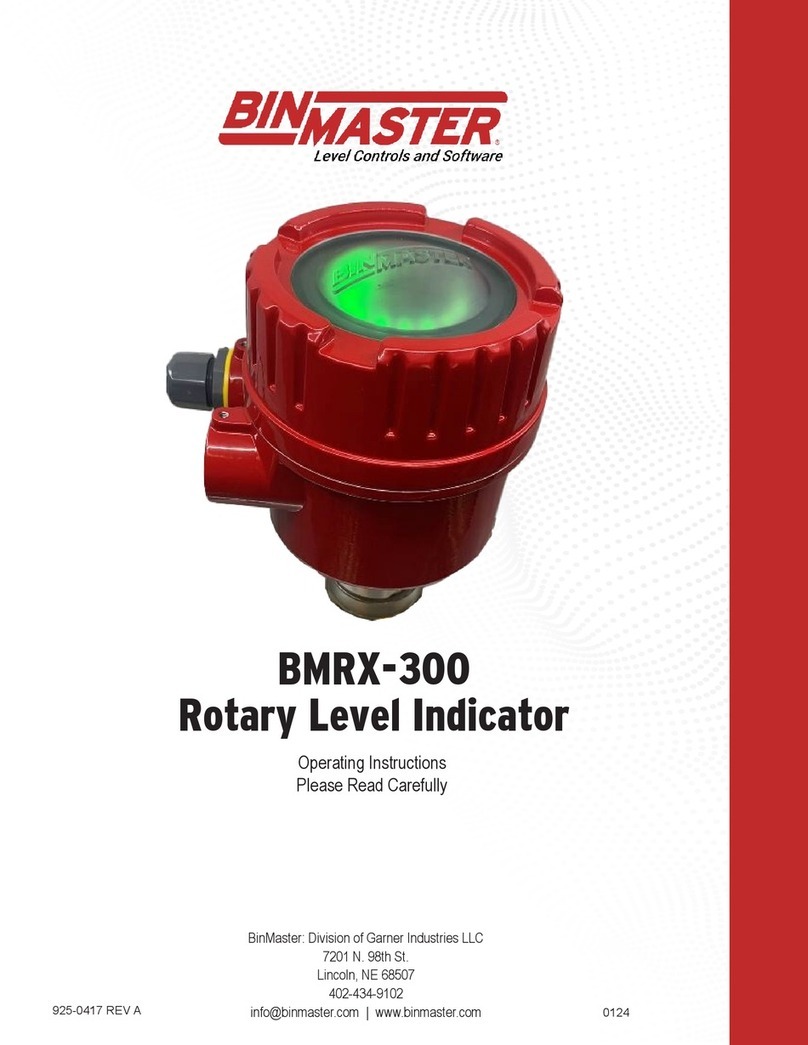
Bin Master
Bin Master BMRX-300 User manual
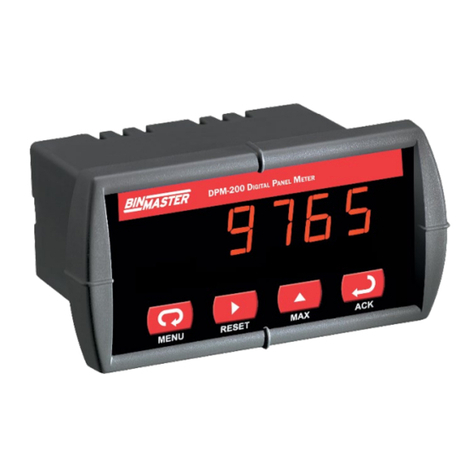
Bin Master
Bin Master DPM-200 User manual
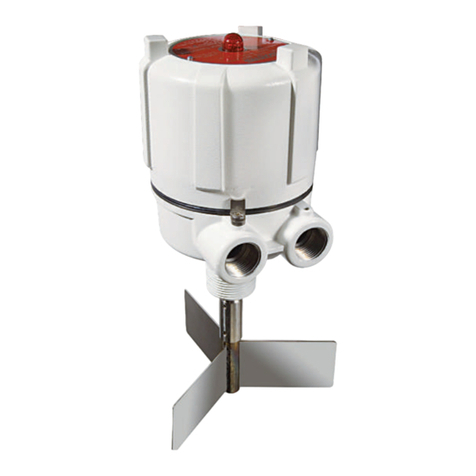
Bin Master
Bin Master MAXIMA+ Series User manual

Bin Master
Bin Master DPM-500 User manual

